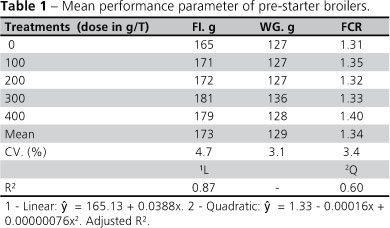Abstract
A fibrolytic enzyme complex was added to the pre-starter diet. Broiler chicks were randomly distributed into five treatments, consisting of a diet with no enzyme addition and four test diets supplemented with 100, 200, 300 and 400g/T of an enzyme complex. The dietary inclusion of the enzyme complex increased weight gain, and the dose of 300g/T improved weight gain and worsened feed conversion ratio.
Galactosidase; galactomannanase; glucanases; xylanases
TECNICAL NOTE
Exogenous enzymes in pre-starter broiler diets based on corn and soybean meal
Lima RBI; Rabello CBVII; Lima SBP deIII; Figueiredo-Lima DFIV; Siqueira JC deV; Vilar da Silva JHVI; Silva EP daVII
IUniversidade Federal da Paraíba. Centro de Ciências Agrárias. Departamento de Zootecnia. Areia, PB, Brasil
IIUniversidade Federal Rural de Pernambuco. Departamento de Zootecnia. Recife, PE, Brasil
IIIUniversidade Federal do Piauí, Campus Professora Cinobelina Elvas. Bom Jesus, PI, Brasil
IVUniversidade Federal Rural de Pernambuco. Unidade Acadêmica de Garanhuns.Garanhuns, Brasil
VUniversidade Federal do Maranhão. Centro de Ciências Agrárias and Ambientais. Chapadinha, MA, Brasil
VIUniversidade Federal da Paraíba. Centro de Ciências Humanas and Sociais. Bananeiras, Brasil
VIIUniversidade Estadual Paulista, Júlio de Mesquita Filho. Jaboticabal, SP, Brasil
Mail Adress
ABSTRACT
A fibrolytic enzyme complex was added to the pre-starter diet. Broiler chicks were randomly distributed into five treatments, consisting of a diet with no enzyme addition and four test diets supplemented with 100, 200, 300 and 400g/T of an enzyme complex. The dietary inclusion of the enzyme complex increased weight gain, and the dose of 300g/T improved weight gain and worsened feed conversion ratio.
Keywords: Galactosidase, galactomannanase, glucanases, xylanases.
INTRODUCTION
The supplementation of exogenous enzymes in pre-starter broiler diets may promote high growth rates; however, the use of fibrolytic enzymes in diets based on corn and soybean meal is difficult to justify.
Non-starch polysaccharides are not found in high levels in conventional corn and soybean meal-based diets, but many broiler farmers supplement feeds with fibrolytic enzymes or carbohydrases during all rearing phases because the sales of commercial enzymes are based on the possible negative correlation between oligosaccharide content and dry matter, protein, and starch digestibility. Despite being used in lower proportion, fibrolytic enzymes are routinely applied during the pre-starter phase.
The present study aimed at evaluating the effects of the addition of a fibrolytic enzyme complex to pre-starter broiler diets based on corn and soybean meal.
MATERIALS AND METHODS
Three hundred and seventy five Ross 308 male chicks were randomly allotted to five treatments with five replicates of 15 birds each. Treatments consisted of a basal diet based on corn and soybean meal (45% CP) and four diets supplemented with 100, 200, 300 or 400 g/T of an enzyme complex. The enzyme complex included 35 U/g α-galactosidase, 110 U/g galactomannanase, 1500 U/g xylanase and 1100 U/g β-glucanase. Feeds were formulated to contain 2950 kcal/kg and 21.7% CP.
The following parameters were evaluated: feed intake, weight gain, feed conversion ratio and drumstick, thigh, breast, heart, liver and proventriculus yields.
Data were submitted to analysis of variance (p<0,05) and, when significance was detected, analysis of regression was applied.
RESULTS
The addition of the enzyme complex influenced the evaluated parameters, as shown in Table 1.
Feed intake linearly increased with the inclusion of the enzyme complex. Weight gain improved with the dose of 300 g/T, but the polynomial models did not fit to the data. The 400g/T dose of the enzyme complex resulted in the worst feed conversion ratio.
No effects of the enzyme complex supplementation on the other parameters were detected.
DISCUSSION
Occasionally, the addition of fibrolytic enzymes to poultry diets may not reveal any significant response due to the low substrate availability in conventional corn and soybean meal diets (Dourado et al., 2009); however, enzyme effects may be associated to a reduction in apparent digestibility coefficients of nutrients.
In adult roosters, xylose digestibility was complete, but metabolizability linearly decreased from 92.5% to 79.4% when its dietary level increased from 2.5 to 10% (Schutte, 1991). In broiler chicks, the dietary inclusion of xylose or arabinose impaired weight gain and feed conversion ratio (Schutte 1990; Schutte et al., 1992). In the present study, the action of fibrolytic enzymes worsened feed conversion ratio, which may have been due to a reduction in diet digestibility caused by the release of xylose and arabinose residues. However, there are several explanations for such observations, and it is often impossible to compare the results of different experiments because of differences in the enzyme complex composition, activity and inclusion level. Sometimes, enzyme activity is indicated, but there are differences in expression units and in the methods of determination of the activity level, which may be incorrectly applied. In addition, when enzymes are added to pre-starter diets, the transition of lipid metabolism to carbohydrate metabolism in this phase is often overlooked.
CONCLUSION
The supplementation of 300g/T of the enzyme complex increase the body weight of 7-day-old broilers.
Mail Adress:
Rodrigo Barbosa Lima
Universidade Federal da Paraíba
Centro de Ciências Agrárias
Departamento de Zootecnia
Rodovia 079, km 12
58.397-000. Areia, PB, Brasil
E-mail: rodrigobarbosalima@hotmail.com
Submitted: August/2010
Approved: March/2011
- Dourado LRB, Sakomura NK, Barbosa NAA, Bonato MA, Kawuauchi IM, Fernandes JBK, Costa FGP. Corn and soybean meal metabolizable energy with the addition of exogenous enzymes for poultry. Revista Brasileira de Ciência Avícola 2009; 11(1):51-55.
- Savory CJ. Metabolic fates of U-14C-labelled monosaccharides and an enzyme-treated cell-wall substrate in the fowl. British Journal of Nutrition 1992; 67:103-114.
- Schutte J, Jong de J, van Weerden EJ, van Baak MJ. Nutritional value of D-xylose and L-arabinose for broiler chicks. British Poultry Science 1992; 33(1):89-100.
- Schutte JB, Leeuwen PV, Lichtendonk WJ. Ileal digestibility and urinary excretion of D-xilose and L-arabinose inileostmized adult roosters. Poultry Science 1991; 70:884-891.
- Schutte JB. Nutritional implications and metabolizable energy value of D-xylose and L-arabinose in chicks. Poultry Science 1990; 69:1724-1730.
Publication Dates
-
Publication in this collection
14 Oct 2011 -
Date of issue
Sept 2011
History
-
Received
Aug 2010 -
Accepted
Mar 2011


